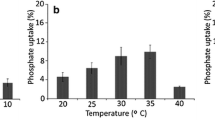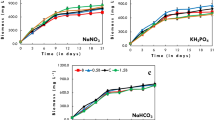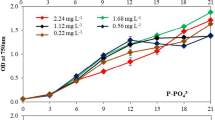Abstract
The effects of macronutrients (NO3 −, NH4 + and PO4 3−) on cell growth and triterpenoids production inCentella asiatica cell suspension cultures were analyzed using the Box-Behnken response surface model experimental design. In screening and optimization experiments, PO4 3− as a single factor significantly influenced cell growth where increasing the phosphate level from 0.1 to 2.4 or 2.6 mM, elevated cell growth from 3.9 to 14–16 g/L. The optimum values predicted from the response surface model are 5.05 mM NH4 +, 15.0 mM NO3 − and 2.6 mM PO4 3−, yielding 16.0 g/L cell dry weight with 99% fitness to the experimental data. While the NH4 +-NO3 − interaction influenced cell growth positively in the optimization experiment, NH4 + and NO3 − as single factors; and interactions of NO3 −-PO4 3−, NH4 +-PO4 3− and NH4 +-NO3 − were all negative in the screening experiment. Cell growth and the final pH level were positively affected by PO4 3−, but negatively affected by NH4 + and NH4 +-PO4 3− interactions. The different effects of factors and their interactions on cell growth and final pH are influenced by a broad or narrow range of macronutrient concentrations. The productions of triterpenoids however were lower than 4 mg/g cell dry weight.
Similar content being viewed by others
References
Croteau, R., T. Kutchan, and N. Lewis (2000) Natural products (Secondary metabolites) pp. 1250–1318. In: B. Buchanan, W. Gruissem, and R. Iones (eds.),Biochemistry & Molecular Biology of Plants. American Society of Plant Physiology, Berkeley, USA.
Nielson, J. (2000) Metabolic engineering.Appl. Microbiol. Biotechnol. 55: 263–283.
Sanchez, S. and A. L. Demain (2001) Metabolic regulation of fermentation process.Enzyme Microbiol. Technol. 51: 895–906.
Matsubayashi, Y. and Y. Sakagami (1998) Effects of medium ammonium-nitrate ratio on competence for asparagus cell division induced by phytosulfokine-α.Plant Cell Rep. 17: 368–372.
Schlatmann, J. E., P. R. H. Moreno, J. L. Vinke, H. J. G. ten Hoopen, R. Verpoorte, and J. J. Heijnen (1994) Effect of oxygen and nutrient limitation on ajmalicine production and related enzyme activities in high density cultures ofCatharantus roseus.Biotechnol. Bioeng. 44: 461–468.
van Gulik, W. M., H. J. G. ten Hoopen, K. Luyben, and K. R. Libbenga (1989) Growth ofCatharantus roseus cell suspension culture in modified chemostat under glucose limiting conditions.Appl. Microbiol. Biotechnol. 30: 270–275.
Abdullah M. A., M. Marziah, M. N. Zakaria, A. M. Ali, N. H. Lajis, and A. B. Ariff (1999) Synergistic effects of medium strategies and sucrose level with nitrogenous compounds, phosphate and myo-inositol onMorinda elliptica cell culture.Asia Pac. J. Mol. Biol. Biotechnol. 7: 61–72.
Omar, R. (2003)Optimization Strategies. Kinetics and Modeling of Cell Growth and Triterpenoids Production in Centella asiaticaCell Culture. M. S. Thesis. Universiti Putra Malaysia, Serdang, Malaysia.
Deming, S. N. (1990) Quality by design—Part 5.Chemtech. 20: 118.
Laugel, C., A. Baillet, and D. Ferrier (1998) Improved HPLC determination of theCentella asiatica terpenes: Analysis in a multiple emulsion, influence of the surfactants on the retention.J. Liq. Chromatography Related Tech. 21: 1333.
Box, G. E. P. and D. W. Behnken (1960) Some new three level designs for the study of quantitative variables.Technometrics 2: 455.
Robinson, G. K. (2000) Practical Strategies for Experimenting. John-Wiley & Sons, NY, USA.
Wen, Z.-Y. and J.-J. Zhong (1997) Effects of initial phosphate concentration on physiological aspects of suspension cultures of rice cells: A kinetic study.Ferment. Bioeng. 83: 381–385.
Oostdam, A. and H. W. van der Plas (1996) A cell suspension ofLinum flavum (L.) in phosphate limited continuous culture.Plant Cell Rep. 16: 188–191.
Salisbury, F. B. and C. W. Ross (1985)Plant Physiology, 3rd ed., pp. 242–243. Wardsworth, Belmont, USA
Sakano, K., Y. Yazaki, K. Okihara, T. Mimura, and S. Kiyota (1995) Lack of control in inorganic phosphate uptake byCatharantus roseus (L.) G. don cells.Plant Physiol. 108: 295–302.
Pilbeam, D. J. and E. A. Kirby (1992) Some aspects of utilization of nitrate and ammonium by plants. pp. 55–90. In: K. Mengel and D. J. Pilbeam (eds.),Nitrogen Metabolism of Plants. Calderon Press, Oxford, UK.
Heuwinkel, H., E. A. Kirkby, J. Le-Bot, and H. Marschner (1992) Phosphorus deficiency enhances molybdenum uptake by tomato plants.J. Plant Nutrition 15: 549.
Mengel, K. and M. Viro (1978) The significant of plant energy status for the uptake and incorporation of ammonium nitrogen by young rice plants.Soil Sci. Plant Nutrient 24: 407.
Kirby, E. A. (1968) Influence of ammonium and nitrate nutrition on cation-anion balance and nitrogen and carbohydrate metabolism in white mustard plants grown in dilute nutrient solution.Soil Sci. 105: 133.
Mattson, S. (1966) The ionic relationship of soil and plant.Acta Agric. Scandinavica 16: 135.
Goyal, S. S. and R. C. Huffaker (1984) Nitrogen toxicity in plants. pp. 97–117. In: R. D. Hauck, J. D. Beaton, C. A. I. Goring, R. G. Hoeft, G. W. Randall, and D. A. Russel (eds.).Nitrogen in Crop Production. American Society of Agriculture, Crop Science Society of America, USA.
Author information
Authors and Affiliations
Corresponding author
Rights and permissions
About this article
Cite this article
Omar, R., Abdullah, M.A., Hasan, M.A. et al. Optimization and elucidation of interactions between ammonium, nitrate and phosphate inCentella asiatica cell culture using response surface methodology. Biotechnol. Bioprocess Eng. 10, 192–197 (2005). https://doi.org/10.1007/BF02932012
Received:
Accepted:
Issue Date:
DOI: https://doi.org/10.1007/BF02932012




